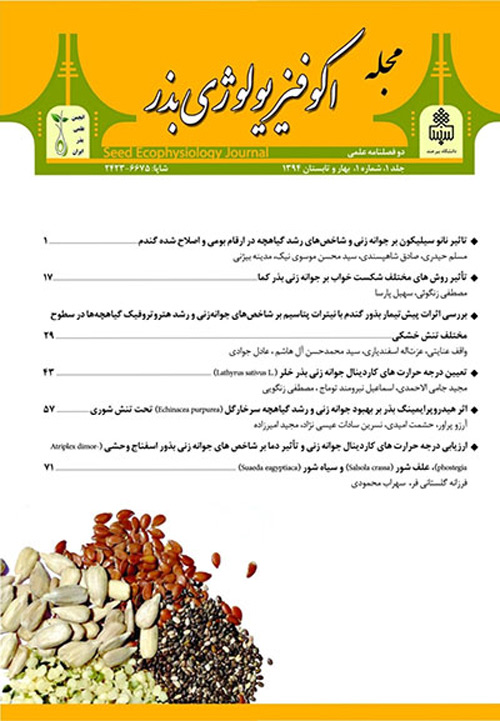The effect of salinity on germination and seedling growth in Cowpea genotypes (Vigna unguiculata)
One of the constraints in development of cowpea cultivation in growing areas of this crop is soil salinity. Soil salinity is a major factor limiting plant productivity, affecting about 95 million hectares worldwide. The UNEP (United Nations Environment Program) estimates that 20% of the agricultural land and 50% of the crop land in the world is salt-stressed (Othman et al, 2006). One of the most important problems in the semi-arid and arid regions is the salinity. In the rainy regions, the salt in the soil is washed by rain and reaches into underground water. Because of that, the salinity is not a problem in the rainy regions while it is not possible that the salt in the soil cannot be washed and it cannot reach the underground water in the semi-arid and arid regions. In these regions, the salt in the soil is collected in the ground water and it is carried towards surface of the soil by ground water movement. Other important reasons for soil salinity are the quality of irrigation water, irregular irrigation, and excessive fertilizer applications (Turkmen et al, 2000). Seed germination is an important and vulnerable stage in the life cycle of terrestrial angiosperms and determines seedling establishment and plant growth. Salinity affects seed germination through osmotic effects, ion toxicity or a combination of the two. In vegetative plants, salt stress causes reduced cell turgor and depressed rates of root and leaf elongation, suggesting that environmental salinity acts primarily on water uptake. Furthermore, high intracellular concentrations of both Na+ and Cl- can inhibit the metabolism of dividing and expanding cells, retarding germination and even leading to seed death (Zhang et al, 2010). The purpose of this research was to study the effects of salt stress on cowpea genotypes seed germination and seedling growth.
In order to investigate the effect of salinity on germination and seedling growth of cowpea (Vigna unguiculata), an experiment was conducted as factorial based on completely randomized design with 4 replications. The study was carried out June 2013 at the genetic and gene nation bank laboratory of Seed and Plant Improvement Institute, Karaj, Iran. Treatments were including of 4 levels of salinity (0, 50, 100 and 150 mM), 15 genotypes of cowpea (Mashhad, Omid bakhsh1, Omid bakhsh 2, 001, 002, 7245, 7254, 7262, 7288, 7244, 7256, 7291, 7289, 7278 and 7305). Four replicates of 6 seeds per Petri dish were used for each treatment. Petri dishes were randomly distributed in temperature controlled incubators (25C; 12-12 hours). The number of seeds germinated in each dish was counted daily for a period of 14 days. Seed were considered germinated when the radical attained a length of 2 mm. Germination percentage, index germination, vigor index germination, germination rate, Plumule dry weight, Plumule fresh weight, radical dry weight and radical fresh weight were estimated at germination and seedling stage. Data were statistically analyzed using analyses of variance (ANOVA) using the MSTAT-C program. Duncan multiple range test was used to compare means at the 5% level.
The results showed that the effects of genotypes and salinity levels on different measured traits were significant at 5% probability level. Germination under saline conditions gave significant reductions for each treatment tested. The interaction effects of genotype and salinity, Mashhad and 7262 cultivars in 150 mM NaCl salinity had the highest final germination percentage (100 %) and 001 genotype had lowest final germination percentage (38.88 %). Also, the highest vigor germination in high salinity (150 mM NaCl) had obtained in Mashhad genotype and with increasing salinity fresh and dry weight of pulumle and radical were increased. Increasing NaCl applications generally decreased the fresh and dry weight of Plumule and fresh and dry weight radical. Mashhad and 7262 genotypes were evaluated as the most resistant and 001 genotype as susceptible genotypes, respectively. Cluster analysis of data showed genotypes categories in three cluster and 001 genotype and Omid bakhsh 2 was placed in separate group and rest of genotypes in another cluster. Based on the results of this experiment, there is necessary genetic diversity among the Cowpea genotypes of Iran for selection of salinity resistant cultivars.
- حق عضویت دریافتی صرف حمایت از نشریات عضو و نگهداری، تکمیل و توسعه مگیران میشود.
- پرداخت حق اشتراک و دانلود مقالات اجازه بازنشر آن در سایر رسانههای چاپی و دیجیتال را به کاربر نمیدهد.


